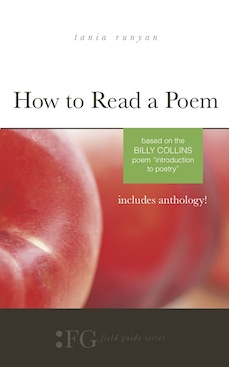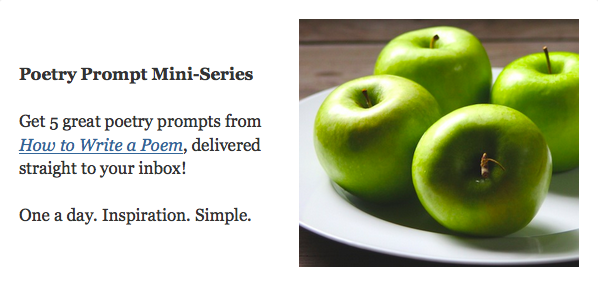
- Publisher: T. S. Poetry Press
- Available in: Paperback, Kindle, Nook
- ISBN: 978-0989854221
- Published: January 1, 2014
How to read a poem. A lot of books want to teach you just that. How is this one different?
Think of it less as an instructional book and more as an invitation. For the reader new to poetry, this guide will open your senses to the combined craft and magic known as “poems”. For the well versed, if you will, this book might make you fall in love again.
How to Read a Poem uses images like the mouse, the hive, the switch (from the Billy Collins poem “Introduction to Poetry”)—to guide readers into new ways of understanding poems. Excellent teaching tool. Anthology included.
From One Young Reader
What Readers Are Saying
I require all my incoming poetry students, in the MFA I direct, to buy and read this book.
—Jeanetta Calhoun Mish
While this book says it’s an invitation, it’s really much more. It’s a conversation—between you (lucky reader), Tania Runyan (funny, helpful friend) and these poems (brilliantly brought to the table by Runyan). No reader, experienced or new to reading poems, will want to miss this winsome and surprising way into the rich, wonderful conversations that poetry makes possible.
—David Wright, Assistant Professor of English at Monmouth College, IL
Runyan expertly brings you into her world of approaching and interpreting poetry, which is both mysterious and ordered. I would recommend this book to anyone hoping to gain insight into poetry. Prepare to have your heart captured!
—Thomas Purnell, Licensed Professional Counselor
Having taught poetry in high schools for over twenty-five years, I’ve grown tired of Intro-to-Poetry texts that feel they must overwhelm the student with the authors’ erudition or the art’s storied history of technique. If there is truly a need for the news only poetry can deliver, then those tomes make dismal advertisements. Tania Runyan has broken with this flat tradition and, in affectionate conversation with the wit of Billy Collins, produced a model for engaging in discovery of poetry’s value—no prior book-learning or companion text required. Which is not to say her ambition is slight; she would thrill to see novices become lifelong readers, even passionate scholars of the art and poets themselves, but she gets it. Her book reads like a playful love letter—a creative intercession on poetry’s behalf—to the hearts of a new generation, those on whom so much, like the future of the art, depends.
—Brad Davis, Poet, teacher, and counselor at Pomfret School
I teach Introduction to Literature, among other courses, and this will be main textbook for the poetry unit from now on.
—Tom Hunley
The Companion Book: How to Write a Poem
👉 Sign up for the FREE series based on the book
Prompts you’ll receive:
1. Imagery: One Must Have a Mind Of
2. Sound: Irresistible Vocabulary
3. Line: Suspense Breaks
4. A-Ha!: Perspective Flash
5. Mystery: Questions
How to Write a Poem: Book Description
Is it possible to teach someone how to write a poem? Or does poetry simply “come from the heart” or from a special talent only some can ever hope to have? Of course there’s no formula for writing an amazing poem. If poems came with instructions like IKEA® coffee tables, we’d all be missing the point.
But this book will give you some strategies—some tools, if you will—to assemble your personal, imaginative raw materials into poems that will surprise and intrigue. These strategies are focused primarily on free verse, yet many of the concepts can also be applied to form poetry, at both the inception and revision stages.
How to Write a Poem uses images like the buzz, the switch, the wave—from the Billy Collins poem “Introduction to Poetry”—to guide writers into new ways of writing poems. Excellent teaching tool. Anthology and prompts included.
How to Write a Poem: What Readers Are Saying
For years I’ve searched for a poetry-writing text that provides enough substance without the inevitable overload of content I’ll never cover. Now my search is complete. The companion to her insightful and accessible How to Read a Poem (and written in the same inviting tone), Tania Runyan’s How to Write a Poem contains three essential elements I’ve yet to find in one poetry-writing text: generous and informed instruction, dozens of compelling example poems, and rich and plentiful exercises that avoid tricks and gimmicks. Any poetry-writing teacher would do well to assign this text. Any writer would do well to draft and revise poems based upon these prompts.
—Nathaniel L. Hansen; Assistant Professor of English & Creative Writing, University of Mary Hardin-Baylor; Director, Windhover Writers’ Festival
How To Write A Poem is a classroom must-have. Through a selection of evocative poetry and a series of accessible exercises, Runyan shows readers how to gather ideas, choose words, strengthen imagery and sound, and she models each of these skills as she writes alongside her readers. This is compassionate, beautiful writing that invites us into the world of poems.
—Callie Feyen, Middle School Teacher, Maryland
I used this book to help teach my high school students how to write a poem. The author has an easy-to-follow process for the reader to use to compose and revise a poem. The anthology of poems included in the book is diverse. I love that the author includes prompts with each poem to get the student to interact with the poem.
—M. Habrych, Amazon reviewer
This book works very well for a college poetry class. Runyan’s work (this book and How to Read a Poem) is accessible, non-threatening, and makes poetry seem fun and relevant. Students enjoy it and are able to apply her ideas to their own writing.
—Laura P., Amazon reviewer
I started with How to Read a Poem by Tania Runyan. Being a first grade teacher, at first, I thought maybe this wouldn’t work for my students. It didn’t take but a few pages and I knew Tania Runyan’s words are what good art is all about. Good art, great writing, stunning performances transcend the simple outline of the piece. There is depth and the ability to give to all ages. My first graders can read poems.
So, on to How to Write a Poem. What seems like a simple book, it is packed with wisdom that reaches across ages and abilities. Tania does what any good teacher knows how to do. She doesn’t give us rules and regulations. We learn how to write poetry whether or not we are beginners or simply want to explore our craft more deeply. If you have a passion for writing poetry, How To Write A Poem is a gentle and experiential way that makes sense.
It is a joy to wander through the book finding what speaks to me at the moment. I revisit it again and again to I fall deeper into words. Tania’s guidance leads her readers and writers along our road of discovery finding the magic within ourselves that is waiting to introduce itself.
Thank you Tania Runyan and T.S. Poetry Press for hitting one out of the ball park once again. You are a gift to those of us who want to be writers. No matter if we are six (my students) or sixty (me) I know I will always find a gem tucked away to help my writers and myself grow and bloom. Thank you!
—Lex, Amazon reviewer
I teach high school creative writing and Runyan’s book is a godsend. I taught an advanced poetry class this past spring, but I had a a group of students with a wide range of poetic knowledge and ability. So I decided to use this book as our foundational text for the whole semester. I was able to use each core idea (image, buzz, line, etc.) as criteria for a rubric that I could use for each poem written over the course of the semester…
…How To Write a Poem is an incredible classroom resource for all young writers—from the novice to the experienced. It is WAY more affordable than most textbooks, and Runyan writes in a way that is encouraging, accessible, and challenging. If you teach writing in any capacity, buy this book. If you yourself have to teach writing but lack confidence in poetry, buy this book for both yourself and your students.
—J. Jacobson, Amazon reviewer
I use this in my Intro to Creative writing class. The chapters are short, include poems at the end (no need to buy expensive anthologies) and easy for the students to work through and then apply what they’ve learned to their own work. I use it in conjunction with How to Read a Poem: Based on the Billy Collins Poem “Introduction to Poetry.”
—Cheryl Russell, Amazon reviewer

